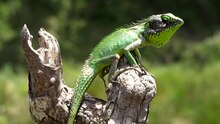Calotes nigrilabris
| Calotes nigrilabris | |
|---|---|

| |
| Female | |
| Scientific classification | |
| Kingdom: | Animalia |
| Phylum: | Chordata |
| Class: | Reptilia |
| Order: | Squamata |
| Suborder: | Iguania |
| Family: | Agamidae |
| Genus: | Calotes |
| Species: | C. nigrilabris
|
| Binomial name | |
| Calotes nigrilabris Peters, 1860
| |
Calotes nigrilabris, the black-cheek lizard, is an agamid species endemic to Sri Lanka.[1] It can be distinguished easily from painted-lipped lizard by having black bar on mouth rather than white or orange bar.
Distribution[]
A submontane and montane species, found at elevations of 1,000 m (3,300 ft) and above. This species is tolerably common at localities such as Nuwara Eliya, , Ohiya, Horton Plains, and Adam's Peak
Description[]
Head is one and a half times width. A row of spines above and at the back of tympanum. Adult male is with swollen cheeks. Gular sacs are not developed. Mid body scale rows are 42–50. Ventrals are larger than dorsals. Dorsum is green unpatterned or with black edged, cream transverse bars or eye-like spots. Head with black markings. Venter is pale green.
Ecology[]
This species is largely arboreal,[2] inhabiting tree trunks, hedges, and shrubs, where it hunts for insects and worms by day. In Horton Plains C. nigrilabris can be found residing on the gorse bushes (Ulex europeus) and Rhododendron leaves to hunt the insect prey (particularly bees) that gets attracted to the flowers.[2][3]
Reproduction[]
Lays up to 4 eggs, measuring 17–23 mm in length and 10–13 mm in width. Hatchlings have mean SVL of 35–50 mm.[4] Two breeding seasons can be observed from November–December and February to March. Hatchlings can be observed following the egg laying in the breeding months after an approximate two months of incubation.
References[]
- ^ Calotes nigrilabris at the Reptarium.cz Reptile Database. Accessed 12 November 2020.
- ^ a b Jayasekara, Dulan; Prabhath, Meegmage; Mahaulpatha, Dharshani (2019-05-16). "Microhabitat utilisation of endemic lizard Calotes nigrilabris in the Grasslands of Horton Plains National Park, Sri Lanka". Journal of Tropical Forestry and Environment. 9: 59–68.
- ^ Somaweera, Ruchira; Somaweera, Nilusha (2009). Lizards of Sri Lanka: a colour guide with field keys. Ed. Chimaira. ISBN 978-3-89973-478-2. OCLC 423783080.
- ^ Mahaulpatha, Dharshani; Jayasekara, Dulan; Prabhath, Meegmage (2017-06-10). "Maturity stage categorization of endemic lizard (Calotes nigrilabris) in the grasslands of HPNP". Wildlanka. 5 (2): 46–51.
External links[]
- https://www.academia.edu/1400803/Calotes_nigrilabris_Peters_1860_Reptilia_Agamidae_Draconinae_a_threatened_highland_agamid_lizard_in_Sri_Lanka
- http://www.wildreach.com/reptile/Sauria/Calotes%20nigrilabris.php
- https://web.archive.org/web/20140928094724/http://www.srilankanreptiles.com/TetrapodReptiles/Agamidae.html
- Calotes
- Reptiles of Sri Lanka
- Endemic fauna of Sri Lanka
- Reptiles described in 1860
- Taxa named by Wilhelm Peters
